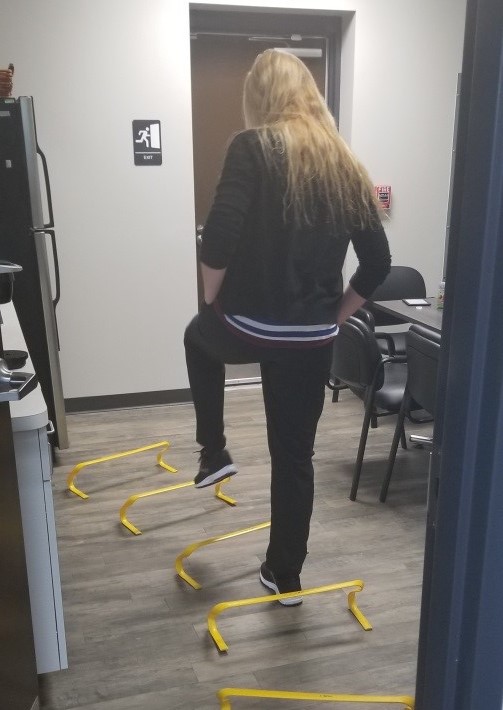Exercise and working from home: Creating a routine
Clinical ExpertiseMay 22, 2020
Has this pandemic changed your normal daily routine? Has working from home become the new normal for you? If so, then you’re likely looking for a new daily routine, which should include a form of exercise each day. Many traditional venues for physical activity, such as gyms, are still limited in access to help combat the spread of COVID-19 and adhere to social distancing guidelines. It is vital to continue exercising for multiple health benefits including building your immune system and relieving stress.
Excessive sitting can affect your metabolism, increase blood pressure, blood sugar and cholesterol, which can lead to weight gain. Remaining in one posture for hours at a time can also affect the muscles in your back, neck, hips, legs and calves.
Here are a few ideas to incorporate fitness into your daily routine:
- Stay active using the “Pomodoro Technique”
- Walk around during meetings

Plan to take a walk during your next virtual meeting. If video is not required during the meeting, try stretching for a few minutes during the meeting. These efforts can provide much needed exercise and a stress-reducing mental lift. Managers and leaders can also consider starting their meetings with five minutes of stretch time to help their teams get movement in throughout the day.
- Take your calls standing up

Similar to walking around during meetings, you can take your calls while standing up or even performing certain bodyweight exercises such as standing marches, hamstring curls or squatting/sit to stands. Standing up during your calls also provides less pressure on your diaphragm resulting in a clearer voice which makes it easier for others to hear you when you’re speaking.
- Grab an exercise partner
Fitness + A Workout Buddy = A Powerful Combination. Many people have started connecting and socializing with friends and family via video calls, so why not incorporate the same concept with working out. Find a friend or group of friends and do a fitness routine while on a video call. Not only will you get the health benefits of the workout, but you will also have extra accountability to stay on track to complete the workout.
- 7 minute work out app
You may be busier than ever with working from home and virtual school, if you have children. No matter your schedule, you need to make time for exercise – even if it’s only seven minutes. When you don’t have 30 or 60 minutes for a full workout, the seven-minute workout packs in a full-body exercise routine in a fraction of the time. You can squeeze these seven minutes in while preparing for dinner or while taking a small break during your Pomodoro time. Several apps and websites provide free seven-minute workouts including this one by Johnson & Johnson. https://7minuteworkout.jnj.com/
- Indoor obstacle course to the fridge

If you have children, a spouse or a roommate who is eager to exercise with you, set up a makeshift obstacle course in your home to add some fun to everyone’s efforts. You can move pieces of furniture or other objects (safely) into your indoor walk or jog path, and have family members weave around them as they perform the course. Depending on what you place in your obstacle course, not only will it help add fitness and activity back in to your daily routine, but you also will improve your strength, balance, motor planning, coordination, sequencing, memory and spatial awareness. Create an obstacle course that you have to perform to get to the refrigerator for a fun way to cut back on over snacking.
- Stair heart rate work out

Running indoors can be challenging for some, especially in tight quarters, so add in extra trips up and down the stairs if you have them in your house/apartment. If you strategically place items that you know you need throughout the day up or downstairs, it will force you to take the stairs more often resulting in added exercise. You can also opt to use only the bathroom upstairs or downstairs.
The Pomodoro Technique is a productivity and time management strategy where you work for 25 minutes straight and then take a five-minute break. Each 25-minute work session is one Pomodoro. You can apply this technique as a way to incorporate exercise into your day by using the five-minute break to move your body.
The Pomodoro Technique is based on the idea that if we focus without distractions on one task for minutes then we will get things done faster. The breaks also help to give your mind a rest and feel good for the next Pomodoro. After you’ve done four Pomodoros, it is recommended that you take a longer 15 to 30-minute break.
During each break, try a different bodyweight exercise: marching in place, push-ups, sit to stands from your chair, squats, crunches, tricep dips, jumping jacks or jump rope, walking lunges, planks, sun salutations — anything that gets your body moving is good. There are several apps available on your phone or online to provide ideas and inspiration.
Adding health and fitness into your daily routine, or keeping it up if you currently have one, is an important factor to staying healthy, fit and safe. Remember to always check with your doctor and care team before starting a new exercise regimen, especially if you’re uncertain if an injury or other health condition would limit your ability to safely complete exercises.
Post a picture of you exercising with the hashtag #WeAreBrooks so we can see what strategies you use to keep fitness in your routine.




